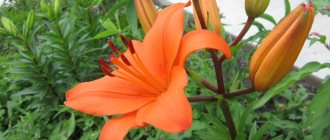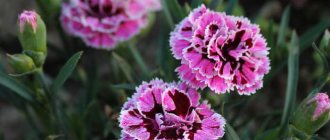Author: Elena N. https://floristics.info/ru/index.php?option=com_contact&view=contact&id=19 Category: Houseplants Published: February 21, 2019Last edits: January 11, 2021
Most of the beautifully flowering plants, after their flowering is complete, go into a dormant state. Plants need rest to restore the energy spent on flower formation and to lay flower buds for the next flowering. Bulbous crops such as amaryllis (hippeastrum) are no exception in this regard. There is a certain procedure for introducing bulbous plants during the dormant period. From our article you will learn:
- how to prepare amaryllis for the dormant period;
- how to cover bulbs overwintering in the ground;
- when to remove bulbs from the ground for the winter;
- how to store bulbs until new planting.
Amaryllis care
Amaryllis is rightfully one of the most attractive house plants. It harmoniously combines the grace of leaves, the tenderness of inflorescences and a delicate aroma. At the same time, caring for the plant is so simple that even a novice gardener can grow an exotic guest from Africa.
Homeland and appearance of amaryllis
Amaryllis is native to South Africa. Very often amaryllis are confused with very similar plants - hippeastrum. However, amaryllis is much less common.
You can also add the following to the differences:
- Amaryllis has smaller inflorescences;
- Amaryllis blooms when the plant has leaves;
- Amaryllis can also be grown in open ground.
Amaryllis leaves are long, green, and shaped like a tongue. The length of the leaf plate reaches half a meter, the width is no more than 3 cm. On one plant, the leaves are arranged in two rows.
The bulb is pear-shaped, half visible from the ground. An adult bulb forms several shoots with buds.
The inflorescences consist of 3-11 flowers of different colors, each of which is formed by six petals. The diameter of one flower is from 6 to 10 cm.
Recommendations for caring for amaryllis
Amaryllis belong to the group of unpretentious plants, caring for which will not cause much difficulty even for novice gardeners.
The main thing is to follow a few simple recommendations:
- Provide amaryllis with plenty of light;
- Protect the plant from excess moisture;
- The plant should be planted in small flowerpots;
- Amaryllis need regular feeding, with the exception of the dormant period;
- The juice of the plant is poisonous, so all work with amaryllis should be done with gloves and avoid contact with mucous membranes, skin and eyes.
Irrigation mode and air humidity
Amaryllis should be watered only after the earthen ball has dried out a little. It is advisable to pour water into the tray to avoid contact of the bulb with moisture.
The maximum air humidity for amaryllis is 80%; at higher humidity there is a high probability of developing a fungal disease. During the dormant period, it is necessary to maintain humidity within 50-90%.
Lighting requirements
Amaryllis is a light-loving plant. It requires bright, diffused light. Direct rays of the sun are possible before 11:00 and after 16:00. During the period of active growth, a long daylight hours is required - at least 16 hours.
The optimal place for growing is south-eastern or south-western window sills.
Temperature
Optimal temperature for amaryllis:
- Daytime – from +20 to +22 degrees;
- Night - not lower than +18 degrees.
During the rest period, the temperature can drop to +10 degrees.
Remember that amaryllis does not tolerate sudden changes in temperature, and a drop below zero can cause the death of the flower.
Fertilizer and feeding
Amaryllis needs feeding during the period of active growth. At this time, it is necessary to alternate organic and mineral fertilizers. The frequency of fertilizing is once every few weeks.
Organic fertilizers:
- Bird droppings: 10 grams per bucket of water (10 liters);
- Mullein: 250 grams per bucket of water (10 liters).
Mineral fertilizers are applied to the soil in the following ratio: 3 grams per liter of water.
It should be remembered that excess nitrogen in the soil leads to the development of a red burn on the plant.
Modern varieties
The development of modern amaryllis breeding proceeds mainly in 3 directions:
- improvement or search for new varieties with classic large flowers of double and non-double forms. I would like to mention such double varieties as Celica, Double Roma, Double Dragon, Ice Queen, Pink Nymph, Merry Christmas, Macarena, Promise, etc. Among the non-double monochrome forms, the varieties Black Pearl, Ampulo, Benfica, Exotica, Faro, are very interesting to my taste. Lemon Lime, Moonlight, Matterhorn, Rosalie, White Baby, etc.;
- searching for fundamentally new two- or multi-color colors, or adding new shades to existing ones. I would note such modern varieties as Charisma, Gervesa, Temptatia, Prelude, Misty, Clown, Neon, Estella, Santa Cruz, Papillio, Pizazz, etc.;
- search for new flower forms, for example, the so-called narrow-petalled varieties of amaryllis or “spiders”, from the English “spider” - spider. This group includes varieties Spotty, Santana, Grandeur, Night Star, Chico, Lima, Evergreen, La Paz, etc. All of them look very beautiful in group compositions, but single flowers, in my opinion, are much inferior to large-flowered hybrids.
Amaryllis transplant
As for the frequency of replanting amaryllis, the opinions of flower growers vary somewhat.
Some recommend replanting the flower once every few years, and some advise changing the flowerpot and soil annually. It is important to understand that transplantation is the most important step in caring for amaryllis. In this way, you can stimulate the flowering of the plant, because a pot that is too spacious or a large number of children on the bulb are the main reasons for the lack of inflorescences.
To properly transplant amaryllis, you must follow some rules:
- The diameter of the flowerpot should be chosen so that the distance between the bulb and the wall of the container does not exceed 3 cm.
- You only need to plant the bulb halfway.
- The best time to transplant amaryllis is July - the time when the plant is preparing to emerge from its dormant period.
- During replanting, it is important to preserve the leaves, as they are a source of nutrition for the young bulb.
- After transplantation, the amaryllis root system is formed within one and a half months.
The acidity of the soil for amaryllis should be in the range of 6.0-6.5 pH.
Soil composition:
- Sod land - two parts;
- Leaf soil - two parts;
- Perlite or sand - two parts;
- Humus is one part.
You can also use an earthen mixture consisting of three parts leaf soil and one part humus.
The soil must be sterilized before use.
Amaryllis propagation
Propagation of amaryllis by seeds
To form seeds, pollen must be transferred from the stamens to the stigma of another inflorescence. Seed ripening occurs over the course of a month at a temperature no higher than +24 degrees. Double pollination significantly increases the efficiency of seed ripening. Amaryllis can self-pollinate. As soon as the seed pods begin to crack, you can collect planting material. Seed germination lasts for six weeks. That is why it is recommended to sow seeds immediately after collecting them.
For better germination, the following substrate is used:
- Leaf soil - two parts;
- Sod land - one part;
- Humus is one part.
The seed planting depth is 0.5 cm. The soil mixture must be kept moist at a temperature of +22 to +25 degrees.
After the formation of two leaves, the plants are transplanted into separate pots. It is important to take into account that varietal characteristics are not preserved when propagated by seeds. For the first few years, the plant should always have leaves.
Vegetative propagation of amaryllis
Types of reproduction:
- Children's department. During the summer transplant, you need to separate the small onion that has roots. Then the baby is germinated and planted in the ground. It is important not to trim the leaves so that the bulb can receive nutrients.
- Dividing the bulb. Without digging up the bulbs of an adult plant, it is necessary to cut off the upper part with the leaves. Then the bulb is cut into four vertical parts. Metal or wooden knitting needles with a diameter of 5 mm are inserted between the cuts. Amaryllis is kept at a temperature of +25 degrees, in bright, diffused light.
Watering should be moderate. Next year in the spring, the young bulbs that have formed can be planted in flowerpots.
The most effective way of reproduction
It is necessary to select amaryllis bulbs that are at least 6 cm in diameter. Clear the planting material from scales and trim the top and bottom parts. Then the bulb is divided into vertical parts, which are soaked for half an hour in a solution of a fungicide, for example, Fundazol.
It is necessary to plant the cuttings in the substrate:
- Perlite - four parts;
- Peat - one part.
Parts of the bulb should be buried no more than a third. After planting, amaryllis is watered. For better rooting, the temperature should be maintained within +22 degrees. Once a week, planting material is treated with a fungicide. After a month, young bulbs form. During the rooting period, the substrate should be slightly moist, but not wet.
How to propagate (pictured)?
Reproduction occurs in the following ways:
- Seminal. This is a labor-intensive method, so it is rarely used. To obtain seeds, flowers will have to be pollinated by hand using a brush, transferring pollen from one flower to another. When the seed box dries and cracks, the resulting material can be planted in moist and nutritious soil.
- Daughter bulbs. If cared for correctly, the plant forms daughter bulbs. They are carefully separated and planted in a substrate consisting of sand and peat or perlite. When the bulbs grow, they are transplanted into a larger container.
- By dividing the bulb. At the end of flowering, cut off the neck with leaves from the bulb and divide it into equal parts. Toothpicks or knitting needles are inserted into the cuts. After some time, the formed new bulbs are transplanted. Watch the video to see how this happens:
Amaryllis blooming
The natural flowering period at home begins in winter, namely in February or early March. However, large bulbs can bloom in April and even in May.
By following simple recommendations, you can regulate the beginning of flowering of the plant. To do this, seven weeks before the desired formation of buds, after a period of dormancy, the flowerpots must be brought into a warm room with good lighting and watering must gradually begin. In this case, the frequency and amount of water should be adjusted depending on the activity of leaf growth and the dryness of the air in the room.
Amaryllis dormant period
The dormant period of amaryllis is an integral part of the proper cultivation of the plant, as well as a necessary condition for abundant flowering.
Amaryllis should be prepared for the dormant period in the second half of summer. At this time, watering the plant is reduced and fertilizing is stopped. By the second half of autumn, watering should be stopped completely. At this point, the plant gradually sheds its leaves and at the same time, active growth of the bulb begins.
That is why gardeners do not recommend cutting off leaves that have not completely dried out.
Since the root system continues to grow throughout the dormant period, amaryllis needs to be watered once every few weeks. Amaryllis is stored in a dark place, at a temperature no higher than +15 degrees.
The duration of the rest period is at least eight weeks.
Where to store the bulb in winter?
The bulbs should overwinter in a dark, cool place, but this is not easy to find in apartment conditions. The balcony is not very suitable for wintering, especially an open one, because there the bulb will freeze and die.
The best option is storage on the bottom shelf in the refrigerator. Every two weeks it is necessary to check the condition of the bulbs. If there is no free space there, then you can simply leave the bulb in the flowerpot.
Before placing the onion in the refrigerator, wrap it in a napkin or toilet paper.
In mid-February, amaryllis should be taken out of the refrigerator and forced to grow.
Diseases and pests of amaryllis
Fungal diseases
The disease appears as red spots and stripes on stems, leaves and flowers. Often the cause of the disease is excess moisture. You can cope with the disease using Bordeaux mixture or foundation.
Insects - pests
- Scale insects. Appear on the bottom of the leaves. They look like brown scales. A white coating forms on the top of the leaves. Most often, scale insects enter the house on new plants.
- Chervets. Appears in the axils of leaves and appears as lumps of cotton wool.
You can fight insects with special chemicals.
FAQ
Why doesn't amaryllis bloom?
As a rule, the absence of inflorescences on amaryllis is associated with improper maintenance conditions:
- Lack of light;
- Not enough nutrients;
- No rest period;
- A sign that the plant is old and needs to be replanted and the resulting bulbs removed;
- The bulb is deeply planted;
- Diseases of the root system.
It is important to consider that a baby bulb can bloom only in the third year after planting, and a plant grown from seeds blooms only after seven years.
Why do amaryllis leaves turn yellow?
There may be several reasons for yellowing and deformation of leaves:
- Damage by aphids or thrips;
- Excess moisture.
If the leaves begin to dry out, it is likely that the plant is preparing for a period of dormancy. In this case, the process is natural and does not require the intervention of a grower. It is necessary to reduce watering and cut them off as the leaves dry completely.
Possible difficulties in growing
The grower's goal when growing Amaryllis is to bloom. But quite often it happens that the plant does not bloom.
Varieties of amaryllis flowers
This can happen for a number of reasons:
- the plant did not have time to rest after the previous rapid flowering;
- the bulb is planted in a pot that is too wide;
- the bulb was buried entirely in the ground;
- the amount of fertilizer is incorrectly calculated, there is a lot of fertilizing with nitrogen;
- the plant does not have enough sun, low temperature in the room;
- the plant is sick;
- The bulb is young, not yet ready to bloom.
Amaryllis care video
Amaryllis is an amazing, exotic beauty native to Africa, which is distinguished not only by its beautiful flowering, but also by its unpretentious character.
Even a novice gardener can grow amaryllis. The flower needs bright light, moderate watering, nutritious soil, compliance with the dormant period and temperature regime, as well as replanting for better development of the plant. The poisonous juice of the flower is an excellent protective agent against insects and pests. You can also share your secrets for caring for amaryllis. If you have questions, ask them in the comments below, we will be happy to answer them.
What to do if something goes wrong - tips and warnings
Sometimes, even with good care, amaryllis refuses to bloom. There may be several reasons in this case:
- the pot is too wide, allowing the plant to spend all its energy on growing “babies” rather than flowering;
- lack of nutrients in the soil;
- poor lighting and unsuitable temperature conditions during the growing season;
- lack of a rest phase;
- infection by fungi and parasites.
The following problems may arise during cultivation:
- Wilting and pale or yellowing of leaves, blackening of flowers . This can happen to flowers placed in extremely damp and cold areas. The solution to the problem will be the normalization of temperature and watering conditions.
- Slow growth against the backdrop of falling leaves . Such symptoms appear during an amaryllis bug infection. To get rid of aphids, it is recommended to wipe the leaves with a solution of potassium soap.
- Light markings on leaves and stems. Sign of a mealybug. Eliminated by wet wiping the leaves and spraying with insecticides.
- Brown spots on leaves. They are caused by a pest - the false scale insect. To heal the plant, you need to prepare a solution of laundry soap and wipe the affected areas with it.
- Bulb rotting. Indicates the presence of a narcissus fly or onion mite. Preventive measures are required before planting, namely disinfection of the soil, bulb, and pot.
If the bulb rots, you can try to revive it as follows:
- Remove damaged areas with a knife.
- Lubricate the cut areas with an antiseptic.
- Dry.
- Process in Maxim.
- Place in a dark place for two days.
- Immediately before planting, remove dried parts.
Even an inexperienced beginner can handle caring for amaryllis. It is enough just to provide it with optimal conditions in accordance with the characteristics of growth and development, as well as to have a small amount of knowledge about planting and replanting the plant. It would be useful to familiarize yourself with the main diseases to which the flower is susceptible and methods of treating them. About diseases, pests and treatment of amaryllis is written here.
You may be interested in our articles about the amaryllis belladonna variety and about other varieties of the plant, as well as publications about caring for the plant in winter. Also read about the differences between amaryllis and hippeastrum.











